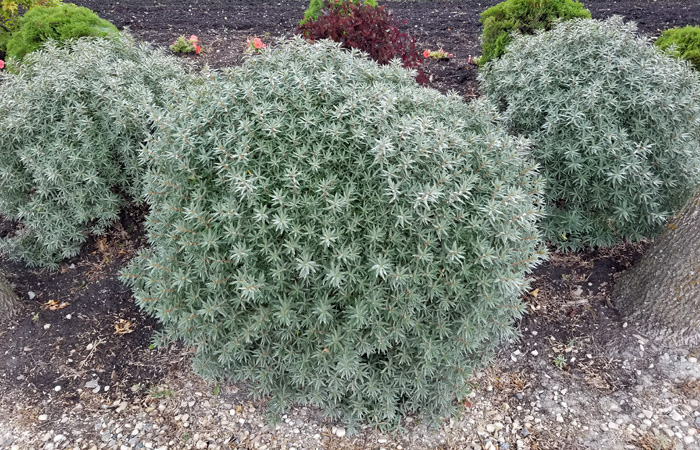If you have been gardening long you have likely heard the term “contrast plant” before. What exactly does this mean? It means something unique! Something that pops! It’s different from the standard greenery. Maybe it has stunning flowers, or a different growth pattern and texture. Maybe the foliage is a different colour in fall or perhaps the whole growing season.
Silver Star Sea Buckthorn lives up to its name with Silvery-blue foliage. The leaves are slim and pointed giving it a different texture than most. It has excellent form with upright branching. You will need to do next to no pruning in order to maintain good shape. I would recommend a light spring pruning to improve structural sturdiness.
Silver Star is a dwarf fruitless male selection that grows only 4 feet tall and wide. It may grow a few sucker shoots from the roots but not aggressive like some poplars and lilacs. The female plants can grow as tall as 10 feet or higher in some cases and the suckering can be much more… insistent. The fruit off these plants is highly nutritious and is considered by some to be a super fruit. I have never had the chance to try it but have heard it is very high in vitamin C and can be quite tart and citrus like. Naturally you will need both the male and female plants within 200 feet of each other to produce a decent yield.
Sea Buckthorn can be found growing native along the coasts in parts of Europe and Asia. It puts up with quite a bit of sea spray and poor soil in its native habitat. Growing in Manitoba clay is no problem for it so long as the ground is not too low and soggy. It is a sun loving plant and can be quite drought tolerant, comparable to Caraganas. If you have a hot corner by the house where nothing seems to live you might want to give Silver Star a chance. (It will still need to be watered every 3-4 days depending on how hot it gets. Always keep an eye on the soil moisture levels.) It is zone 2 cold tolerant but we have seen some tip freeing in bad years. Nothing a spring pruning can’t fix.
You likely noticed the word “thorn” in the name. For some people this is a red flag. Never fear! The only thorns growing on this plant are on the very tip of the branches. One thorn each, small, but sharp. Not nearly as bad as their fruit bearing female counterparts.
Next time you are considering adding something new and different to your shrub gardens perhaps a Sea Buckthorn can be the star of the show.




